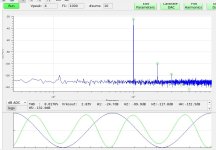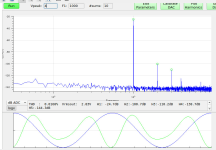Based on the circuit shown by Papa at the BAF 2023, I have built the F5m using easily modified DIYAudio Store F5 boards from long ago. I installed the boards on my prototyping chassis configured to handle the FirstWatt standard +/-24V power and a subset of the Universal Mounting Spec heatsink holes.
Since my heatsinks are fairly large (7" tall Heatsink USA 10.080" wide C/W/3": approximately .80), I biased the output FETs at around 1.35A, giving a heatsink temperature rise of 23C.
The distortion measurements are consistent with what Papa showed in the BAF 2023 video presentation.
The damping factor measured at around 26.
How does it sound? Amazing for such a simple amplifier with A/B listening against more powerful and lower distortion amplifiers. Plenty of power for my 88dB sensitivity speakers in rather large room.
Hats of to Papa, the circuit magician.



Since my heatsinks are fairly large (7" tall Heatsink USA 10.080" wide C/W/3": approximately .80), I biased the output FETs at around 1.35A, giving a heatsink temperature rise of 23C.
The distortion measurements are consistent with what Papa showed in the BAF 2023 video presentation.
The damping factor measured at around 26.
How does it sound? Amazing for such a simple amplifier with A/B listening against more powerful and lower distortion amplifiers. Plenty of power for my 88dB sensitivity speakers in rather large room.
Hats of to Papa, the circuit magician.
I didn't mention the power supplies. The left channel, shown in the image of the provious post, is powered by 2 x Mean Well IRM-90-24ST power modules, with an simple RC output filter. The right channeel is powered from the "standard" 300VA +/-24 volt linear supply.
What is interesting is the noise floor with the Mean Well switching is 10dB lower that with the linear supply but both are good. There is no discernable noise with my ear to the speakers.
This suggests that the "cheapest" option for powering 2 channels of the F5m might be to use two higher output wattage, 24V switching supplies, such as the Mean Well LRS-150F-24 rather than the "standard" linear supply.
Shown below are the left and right channel distortion spectra at 1kHz, 1W, 8R load.
What is interesting is the noise floor with the Mean Well switching is 10dB lower that with the linear supply but both are good. There is no discernable noise with my ear to the speakers.
This suggests that the "cheapest" option for powering 2 channels of the F5m might be to use two higher output wattage, 24V switching supplies, such as the Mean Well LRS-150F-24 rather than the "standard" linear supply.
Shown below are the left and right channel distortion spectra at 1kHz, 1W, 8R load.
Attachments
This suggests that the "cheapest" option for powering 2 channels of the F5m might be to use two higher output wattage, 24V switching supplies, such as the Mean Well LRS-150F-24 rather than the "standard" linear supply.
It's not just less expensive, it seems to have some actual advantages, and as it turns out we've got a team (well, Mark, Patrick and myself...) working on a filtered solution for the LRS-150-24 and do exactly that!
With the simple RC filter I used, I couldn't see any problems with IRM-90-24ST noise. I did see a low level spike in the spectrum at around 48kHz due to fluorescent lights.
The big problems for reducing costs are the heatsinks and chassis. And eventually figuring out how to deal with the lack of p-channel jfets.
The big problems for reducing costs are the heatsinks and chassis. And eventually figuring out how to deal with the lack of p-channel jfets.
@marconi see BAF videos for a brief review.
https://burningampfestival.com/videos/
F5m where m stands for minimalist I believe. Fewer parts; lower cost for cheapskate DIYers.
https://burningampfestival.com/videos/
F5m where m stands for minimalist I believe. Fewer parts; lower cost for cheapskate DIYers.
Regarding the F5M, two questions come to mind:
1. What grade (Gr, B or V) JFET is required?
2. Why no gate stopper resistors?
1. pretty much BL needed; V possible, GR too - but in case of GR I would go to double them
2. Pa took care of all things HF with 22K input gate resistor
https://burningampfestival.com/videos/
Aren't gate stoppers supposed to be close to the gates of the mosfets?22K input gate resistor
Hugo
you can put them if you wish
as I wrote:
as I wrote:
Pa took care of all things HF with 22K input gate resistor
I didn't mention the power supplies. The left channel, shown in the image of the provious post, is powered by 2 x Mean Well IRM-90-24ST power modules, with an simple RC output filter. The right channeel is powered from the "standard" 300VA +/-24 volt linear supply.
What is interesting is the noise floor with the Mean Well switching is 10dB lower that with the linear supply but both are good. There is no discernable noise with my ear to the speakers.
This suggests that the "cheapest" option for powering 2 channels of the F5m might be to use two higher output wattage, 24V switching supplies, such as the Mean Well LRS-150F-24 rather than the "standard" linear supply.
Shown below are the left and right channel distortion spectra at 1kHz, 1W, 8R load.
Have you seen any low frequency aliasing noise due to using two of the same switching supplies?
P.S. It actually wouldn't be LF (except relative to switching frequency), of course, and would "walk around" and allude measurement.
Last edited:
Maybe. When making distortion spectrum measurements I would occasionally see weird behavior that eventually went away. I should see if I can repeat that behavior and see if it only appears on the channel with the SMPS and not the channel with the linear supply.Have you seen any low frequency aliasing noise due to using two of the same switching supplies?
P.S. It actually wouldn't be LF (except relative to switching frequency), of course, and would "walk around" and allude measurement.
I can imagine that both fsw are so far down in level by the time they are in the audio circuit, that any aliasing would just be too low. But it's been a concern. It would be nice if you could sync different supplies, but I've never seem any of this type that have that feature.
Zen
Sorry for the time delay, other side of the planet in bed asleep. I thought B version would do and was curious about the 22k resistor's higher than usual value. Currently battening down for Cyclone Jasper, thank goodness has downgraded to a Category One, Yasi was the worst in 2011 at Cat 5. Part of the fun living in the tropics!
Sorry for the time delay, other side of the planet in bed asleep. I thought B version would do and was curious about the 22k resistor's higher than usual value. Currently battening down for Cyclone Jasper, thank goodness has downgraded to a Category One, Yasi was the worst in 2011 at Cat 5. Part of the fun living in the tropics!
- Home
- Amplifiers
- Pass Labs
- Pass F5m





